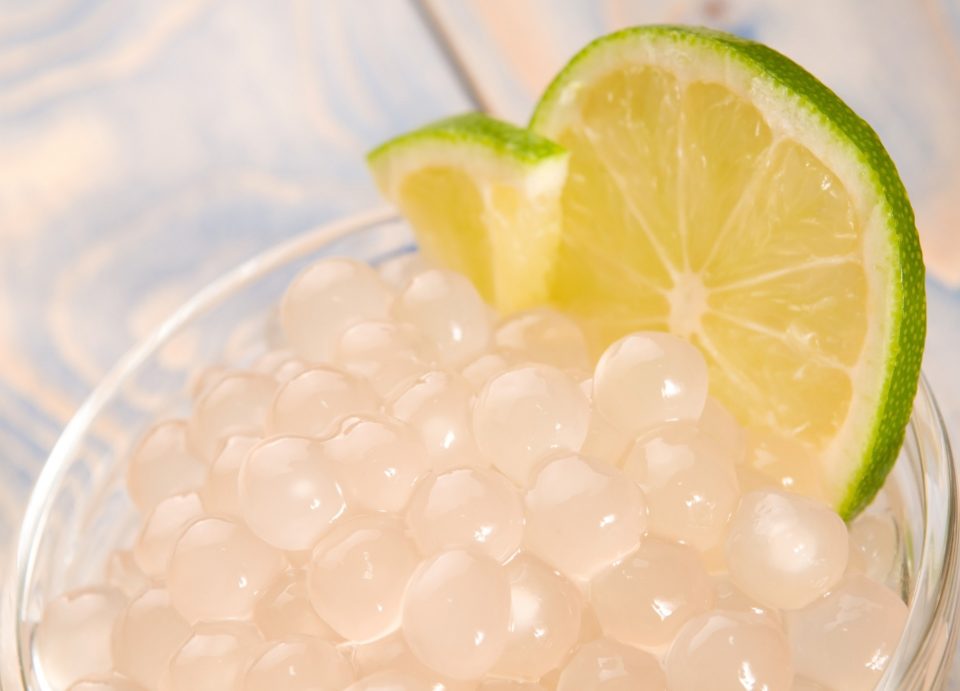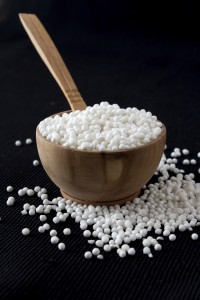The Guilty (and Healthy) Pleasures of Yuca


 When talking to friends and colleagues about new, healthy foods to try, I sometimes have to assume a professorial role and do some explaining. This is the case with yuca (pronounced, yoo-kah), also known as cassava and frequently confused with yucca (yuk-ah). Yuca is a plant that is grown and eaten in Latin America, Africa, South Asia and the Caribbean. It has a starchy root that among other things, can be made into tapioca. Yucca, on the other hand, is an ornamental plant with spiky leaves and tall clusters of white flowers. It grows in the Southern and Western parts of the U.S., including Florida, New Mexico, and California. Yuccas don’t have the edible root of the yuca.
When talking to friends and colleagues about new, healthy foods to try, I sometimes have to assume a professorial role and do some explaining. This is the case with yuca (pronounced, yoo-kah), also known as cassava and frequently confused with yucca (yuk-ah). Yuca is a plant that is grown and eaten in Latin America, Africa, South Asia and the Caribbean. It has a starchy root that among other things, can be made into tapioca. Yucca, on the other hand, is an ornamental plant with spiky leaves and tall clusters of white flowers. It grows in the Southern and Western parts of the U.S., including Florida, New Mexico, and California. Yuccas don’t have the edible root of the yuca.
Now that I’ve clarified the difference, I’ll tell you about yuca/cassava and what makes it a delicious FoodTrient. Back home in the Philippines, it’s called cassava. We used it mostly for desserts like pudding and cake, but if you steam it and mash it, it makes a tasty and healthful starch alternative to potatoes and rice. When exposed to the air, the white flesh becomes sort of speckled mauve in color. The taste is slightly sweet and nutty and like yams or sweet potatoes, yuca can have sweet or savory applications.
SAFETY TIP:
It’s very important to peel it completely before cooking and it is never eaten raw. The skin contains cyanide, which at certain levels is toxic.
There’s a dish we would make called Arroz a la Cubana or “Cuban Style Rice.” You brown ground meat—in the Philippines we’d use pork, but now I like to use chicken or turkey—onions and tomatoes and serve it over rice. For a change I’d use cassava for its more interesting flavor. You peel and cut the cassava into cubes, steam until tender, sprinkle with a little olive or canola oil and roast in the oven. In Latin cuisine, they frequently cut the root into long pieces, fry them and serve them like French fries. They are addictive!
Besides its versatility and delicious flavor, yuca/cassava is highly nutritious, providing complex carbohydrates, vitamins and minerals.
- High in healthy carbohydrates – Yuca/cassava contains about 38 grams of carbohydrates per 100-gram serving. The recommended daily intake for adults is 130 grams of carbs a day. Carbohydrates are essential for energy and the nervous system.
- Contains minimal fat and no cholesterol.
- Has a moderate amount of dietary fiber – Complex carbohydrates such as those in yuca create a feeling of fullness, which helps weight control. Fiber also helps prevent constipation, stabilizes blood sugar levels and reduces the risk of high cholesterol.
- A good source of vitamin C — The RDI of vitamin C is about 80 milligrams for adults. Yuca/cassava provides about 21 milligrams per 100-gram serving. Vitamin C is responsible for many functions, such as wound healing, building connective tissue and fighting infections.
- A source for B-complex vitamins – Including folates, thiamin, pyridoxine (vitamin B-6), riboflavin, and pantothenic acid. These essential nutrients help the body convert food into fuel, keeping it energized throughout the day.
- Contains manganese – A 100 gram serving of yuca/cassava contains 19% of the RDI of manganese, which is important for strengthening connective tissue, sex hormone production and blood clotting. Legumes, such as beans, peas and lentils, make good pairings with yuca root to create a manganese-packed meal.
- Provides essential minerals – Yuca/cassava is important to inhabitants of tropical regions because it is one of the chief sources of vital trace minerals like zinc, magnesium, copper and iron. It also contains 6% of the RDI of potassium, which helps regulate heart rate and blood pressure.
- High in antioxidants – The flesh of a yuca root is white. Fruits and vegetables with white coloring contain antioxidants called anthoxanthins, which help reduce the risk of heart disease, stomach cancer and high blood pressure according to nutrition specialist Julie Garden-Robinson.
 You can find yuca root in Asian and Latin markets or at markets like Sprouts or Whole Foods. When fresh it usually comes encased in wax to protect it. You can also find peeled yuca/cassava in the frozen vegetable section. If you’re using fresh, wash it carefully, pat dry and peel off the brown skin with a sharp knife. Never eat the skin of yuca/cassava and always cook the vegetable before eating.
You can find yuca root in Asian and Latin markets or at markets like Sprouts or Whole Foods. When fresh it usually comes encased in wax to protect it. You can also find peeled yuca/cassava in the frozen vegetable section. If you’re using fresh, wash it carefully, pat dry and peel off the brown skin with a sharp knife. Never eat the skin of yuca/cassava and always cook the vegetable before eating.
Here’s a recipe for delicious, healthy Yuca Fries, which are actually baked. Customize them by sprinkling with turmeric, a powerful antioxidant or granulated garlic, which contains compounds that reduce blood pressure.
Roasted Yuca Fries
Serves 2-4
Ingredients:
2 medium fresh yuca/cassava or 6 frozen yuca sections
Olive oil
Salt & pepper to taste
A pinch of dried cilantro leaves (or your favorite dried herbs)
Fresh lime juice
Directions:
1. Preheat oven to 425º F
2. For fresh yuca/cassava: Peel the tough, waxy brown skin and also the pinkish-purplish layer under the brown skin. Cut into three-inch sections, place in a pot with enough tap water to cover, and let boil over medium-high heat for 10-15 minutes or until fork-tender and the ends start to split open.
3. For frozen yuca/cassava: Since it is already peeled and divided into sections, place in a pot with enough tap water to cover, and let boil over medium-high heat for about 15 minutes or until fork-tender and the ends start to split open.
4. Remove from water using a slotted spoon and drain on paper towels. When they are cool enough to handle, cut lengthwise and remove the thin, woody stick that runs through the middle.
5. Cut into sticks or chunks and place them in a single layer onto a baking sheet. Drizzle with olive or canola oil, and season with salt, pepper, and dried cilantro. Bake for about 20 minutes, turning once. Fries are done when they are crispy on the outside and tender on the inside. Season with more salt & pepper, if desired. Squeeze a little fresh lime juice.
For even more FoodTrients value, try these dips from my book, THE AGE GRACEFULLY COOKBOOK: The Power of FOODTRIENTS to Promote Health and Well-Being for a Joyful and Sustainable Life:
 Moringa Dip
Moringa Dip
Made with moringa, which is available online and at health food stores, Moringa Dip is loaded with protein, calcium, iron, vitamins A and C and potassium. I also serve it with Grilled Artichokes.
Serves 4-6
2-3 Tbs. olive oil
1 cup olive oil mayonnaise
1 Tbs. finely chopped red onion
1 Tbs. finely chopped sweet pickles or sweet pickle relish
½ cup fresh moringa leaves or 1 tsp. moringa powder dissolved in 1 Tbs. warm water
Sea salt and ground pepper to taste
Papaya Salsa
 For a tropical taste, make a batch of Papaya Salsa. This refreshing relish will help boost your immune system and keep your skin young and elastic. Papaya is rich in vitamin C and beta-carotene, which your body converts to vitamin A. It’s also high in potassium. Certain enzymes in papaya aid digestion.
For a tropical taste, make a batch of Papaya Salsa. This refreshing relish will help boost your immune system and keep your skin young and elastic. Papaya is rich in vitamin C and beta-carotene, which your body converts to vitamin A. It’s also high in potassium. Certain enzymes in papaya aid digestion.
Yields about 4 cups
2 cups cubed papaya, ripe but still firm
¼ cup seeded and chopped red bell pepper
¼ cup chopped red onion
1 tsp. minced garlic
½ cup chopped fresh cilantro
½ tsp. seeded and chopped jalapeno pepper (optional)
2 Tbs. lime juice (about 1 lime)
2 Tbs. lemon juice (about 1 lemon)
1 tsp. red wine vinegar
Sea salt and ground pepper to taste
Combine all the ingredients in a large bowl and mix well with a wooden spoon.
 Yuca Coconut Delight
Yuca Coconut Delight
This is an easy, healthy dessert my mother used to make for us when I was growing up in the Philippines. The yuca has a naturally sweet, nutty taste, so you need minimal sugar, while the coconut provides a quick energy boost, dietary fiber and slows down the release of glucose.
Yields about 4 servings
1 lb. fresh or frozen yuca, sliced about ¼” thick
¼ cup butter, melted
¼ cup sugar
1 cup shredded coconut, fresh or dried
Directions
- Steam the yuca slices in a steamer or pot with a small amount of water till tender, about 10 minutes
- Arrange slices in a shallow dish
- Drizzle with melted butter, sprinkle the sugar and the shredded coconut
- Serve warm or at room temperature
- For an added FoodTrient boost and a different flavor, sprinkle with ground cinnamon
